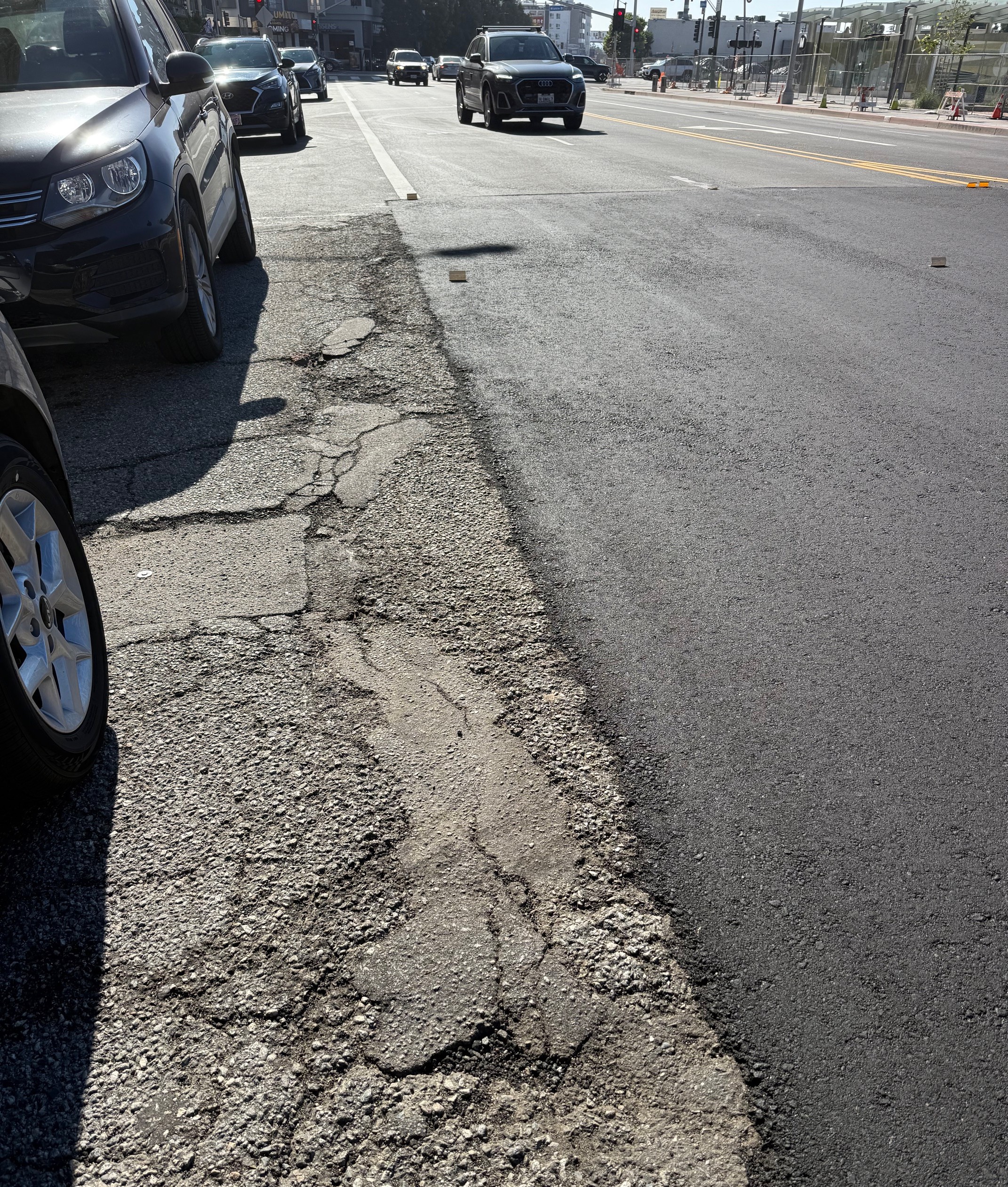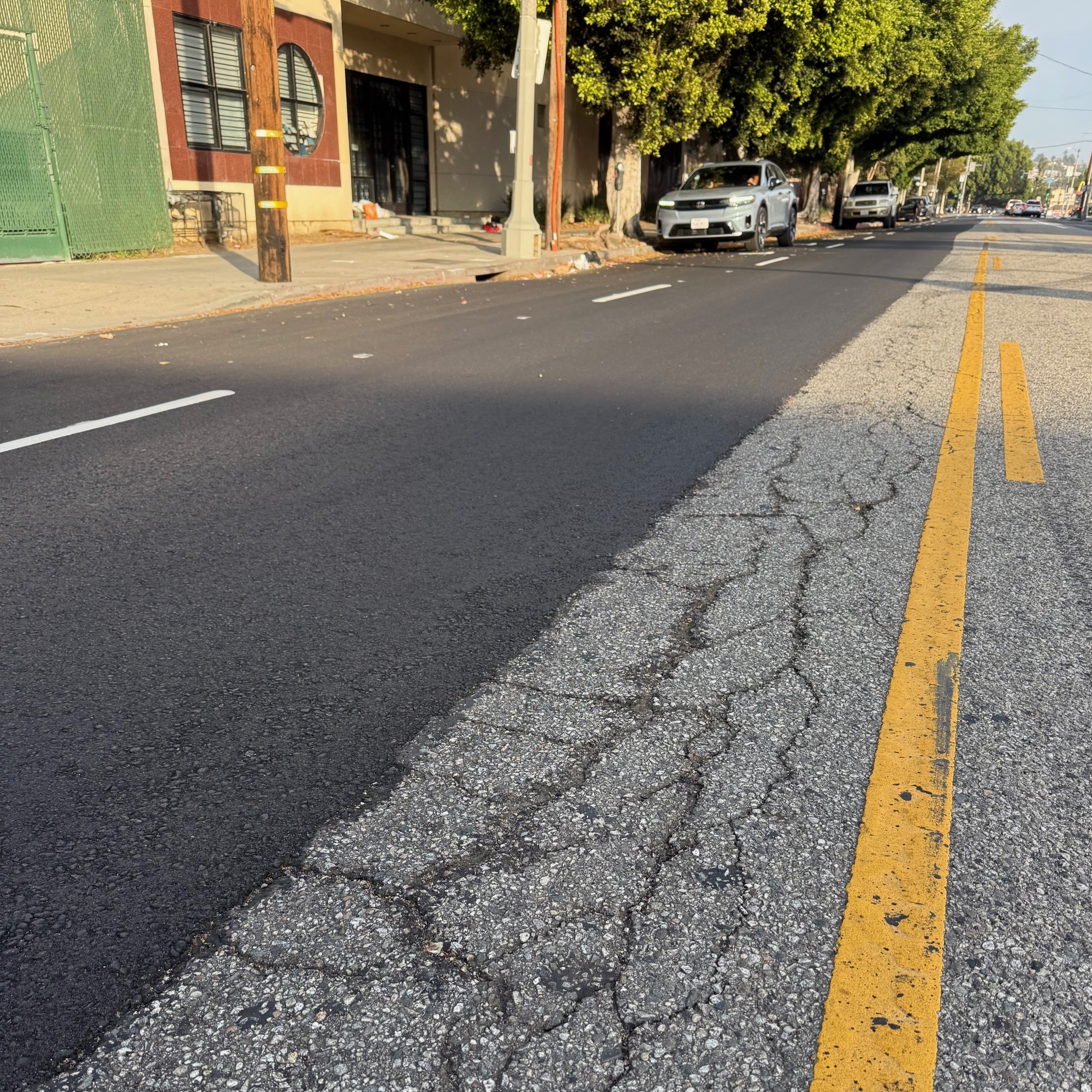Last month, in agreement with the findings of the Use of Force Review Board (UOFRB) and LAPD Chief Michel Moore, the Board of Police Commissioners ruled that Sergeant Brett Hayhoe acted out of policy when he committed what most lay people – and the LAPD in just about any other circumstance – would refer to as a drive-by shooting.

On July 18, 2022, Hayhoe had pulled up alongside an unarmed 39-year-old Black veteran with severe mental illness and – while continuing to steer his patrol vehicle with one hand – pointed a gun out the passenger side window, squeezed off two rounds as the man ran from him, and managed to spark contagious fire from officer Daryl Glover Jr., who, along with officer Nelson Martinez, had been trailing behind the man on foot. That man, Jermaine Petit, had been struck in his left shoulder and jaw (per LAPD) and broken his jaw when he fell to the ground (per the lawsuit filed on Petit’s behalf). Petit thankfully survived the encounter.
The sheer recklessness displayed by Hayhoe was shocking. Yet, the findings in the case were neither as critical nor as punitive as they could have been.

A close read of the Chief’s report about the adjudication process suggests that Hayhoe – who has spent time in the orbits of both Moore and former Chief Charlie Beck – was granted an inordinate amount of grace. Not least by Moore himself. That grace, in turn, extended cover to Glover, whose decision to open fire on Petit was found to be in policy, despite the fact that Glover had been informed by Martinez that Petit was not holding a gun.
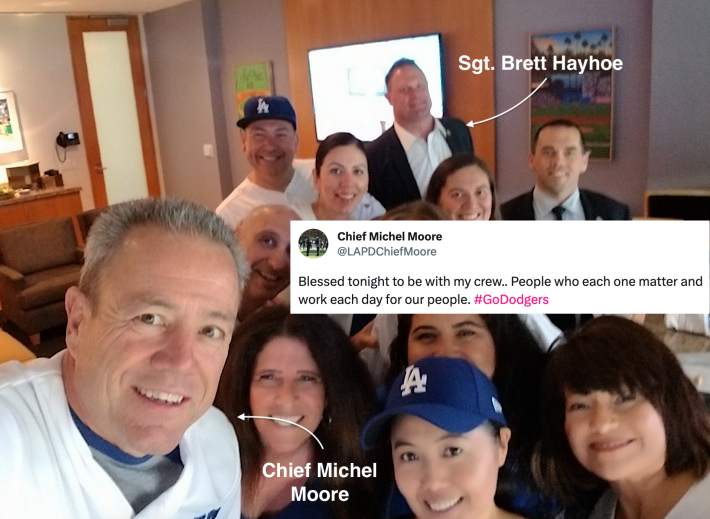
For those who have followed the Petit case closely, this should come as no surprise.
As previously reported by Streetsblog, in the days and weeks following the shooting, the department bent over backwards to shield both officers, and Hayhoe in particular, from scrutiny. They would not acknowledge Petit was unarmed until the day after the shooting. Then, a week later, at a town hall on the incident, they backtracked a bit, describing the car part Petit was carrying as resembling a "nonfunctioning firearm" and lambasting the media for having reported Petit was unarmed.
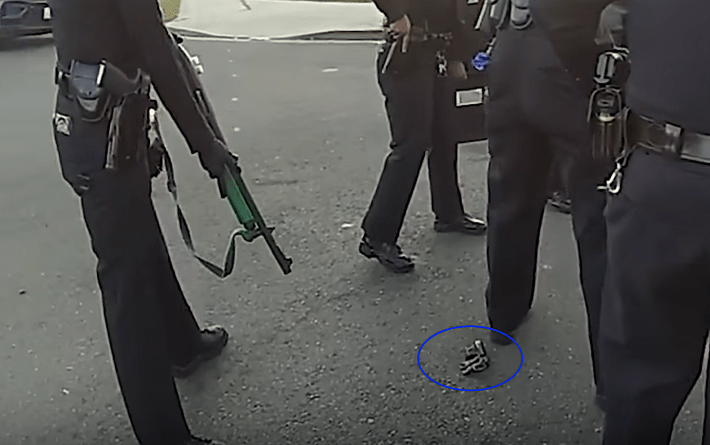
LAPD was even cagey with journalists seeking confirmation that Hayhoe was the person seen driving the patrol vehicle in the critical incident briefing video; several reported to me they could not get that confirmation and instead were encouraged to focus their attention on the officers following Petit on foot.
Still, it was rather extraordinary to see Moore pen an actively misleading – and demonstrably false – summary introduction that fundamentally changes the nature of the shooting. Instead of Hayhoe opening fire on an unarmed, fleeing man and triggering contagious fire from a subordinate, which is what the footage clearly shows, Moore’s synopsis describes two heroic officers simultaneously opening fire on someone taking aim at Hayhoe (below).

The UOFRB appears to have taken its cues from Moore. It never holds Hayhoe’s claims about Petit’s actions or the threat Petit allegedly posed up against the body cam footage.
The failure to make a single reference to Petit’s mental health status or how it impacted his response to having guns pointed at his chest or his ability to comply with commands is the icing on the cake.
The reason for doing so is clear: the omission makes the officers' claims they were locked in a kill-or-be-killed scenario with a violent aggressor sound more credible. But that distortion of Petit's demeanor also resulted in the board advocating for him to have been approached with an even greater show of force – something which has not infrequently resulted in the person in crisis being killed (e.g. the case of Margarito "Junior" López). And it meant that none of the tactical debriefs recommended by the Chief or the UOFRB addressed how the officers could better engage subjects exhibiting signs of mental illness.
__________
Should Hayhoe face any penalties for the drive-by, it is unlikely they will be substantial. A 2022 report from the Inspector General found that in cases where shootings had been ruled out of policy, the majority of the officers in question were able to avoid serious discipline. In recent years, the ability of officers to appeal their cases before all-civilian Board of Rights panels has resulted in even greater leniency. So much so that Chief Moore himself has complained the civilian panels undermine his ability to discipline and fire officers who engage in egregious misconduct.
A look at the LAPD's internal adjudication process, however, suggests the Chief himself can and does play a significant role in sanitizing, excusing, and reframing officers' actions long before the case ever makes it to the Police Commission for adjudication, let alone a Board of Rights review. When combined with the extraordinary public relations campaigns the department often launches in the wake of officer-involved shootings, it's no surprise that stronger penalties and deeper structural reform both remain so elusive.
The Petit case is particularly eye-opening in this regard. So Streetsblog has highlighted a few key observations from the Chief's report to the Police Commission, below.
1. The Chief's report never acknowledges Petit was fleeing at the time he was shot
The UOFRB made the right call by ruling Hayhoe’s decision to open fire out of policy. They had little choice: LAPD’s moving vehicles policy prohibits the discharge of weapons from a moving vehicle except in exigent circumstances. Still, their stated reason for doing so softens the ruling's blow.
The report describes Hayhoe’s sudden and unnecessary escalation as having “created the exigency” that ultimately led to the shooting. By pulling up alongside Petit, the board concluded, Hayhoe had left himself physically vulnerable and at such risk for being shot that he ultimately believed - or at least was able to claim he believed - he was compelled to open fire to save his own life.
The UOFRB's focus on tactics and officer safety is a product of their purview. But the framing of their finding also rests on the wholesale acceptance of Hayhoe's claims. If, during deliberations, the board ever discussed that Hayhoe had opened fire on a mentally ill unarmed man who was very clearly fleeing from him at the time, the report does not mention it. The glaring disconnect between Hayhoe's account and the timeline of actual events is also unremarked upon.
Instead, significant blame is placed on Petit, who the Chief asserts had “limited the officers’ ability to de-escalate the situation.”
It's a ludicrous assertion.
It is indeed true that Petit, who suffers from PTSD and schizophrenia, had behaved erratically earlier that day. He had alarmed the Leimert Park neighbors who had confronted him as he rummaged through trash cans in the neighborhood. One of the 911 callers was even convinced Petit had brandished a pistol at him.
But as officer Martinez quickly discerned upon engaging Petit, the black metal object Petit was gesticulating with as he walked was not a firearm.
De-escalation proved no problem for Martinez, who immediately lowered his weapon and advised Glover of what he had observed, as seen in footage from his own body cam (below). Instead, it was Hayhoe swooping in at that very moment with his service weapon already pointed out the window that robbed the officers of the opportunity to reorient their approach.

Per the statements excerpted in the Chief's report, Hayhoe initially claimed he had pulled up alongside Petit to keep him from heading down a residential street. He also said he hadn't seen anything in Petit's hands and had only unholstered his firearm in response to Petit turning towards him and fumbling at his waistband, as if “he was possibly going to retrieve a weapon.”
Hayhoe’s own body cam, in contrast, shows he had drawn and pointed it out the window well before then.
Specifically, his movements in the car suggest he unholstered his gun at ~19:33:38 (the same moment Martinez saw what Petit was waving and stated aloud that it wasn't a gun). The reflection in the console indicates Hayhoe was pointing the gun out the window by 19:33:40-1, at least four full seconds before Petit turned to face him at 19:33:45.
Sgt. Brett Hayhoe's arm/gun can be seen reflected in the console in the body cam footage released by @LAPDHQ (I've zoomed in here, but video is otherwise unaltered by me; there is no audio and it is not graphic). At least one shot is fired at 19:33:47. See the 🧵 for more: https://t.co/fJ9IKIfozF pic.twitter.com/PadGwrLrDx
— sahra (@sahrasulaiman) September 5, 2022
Hayhoe later contradicted his own account and told investigators Petit already had something in his hand and had assumed a “close contact [shooting] position" when he turned toward the sergeant. "He wasn't turned to the side. He wasn’t bladed at an angle. He was literally looking straight in the eye with me," Hayhoe said of Petit. "His front torso facing my vehicle with his elbow cocked, like tucked near his hip, and it was, like, in a 90-degree angle, and his hand was in a - was positioned around an object in a pistol-like grip."
Having “immediately recognized that item as a hand gun,” Hayhoe continued, “I was already on target and at that point I believe, you know, it was an immediate defense of life situation for myself.” If Petit had “had the intent to shoot…I would have been shot,” he said.
Yet the body cam footage clearly shows that the unarmed Petit's only "intent" was to get away from the officers who were pointing guns at him.
He had broken into a trot after spotting Hayhoe’s weapon at 19:33:40-1 and never stopped moving. When he did turn his body toward the sergeant at 19:33:45-6 (below), it was for just under two seconds. But rather than pause to assume a shooting stance, he had continued moving parallel to Hayhoe via a bouncy lateral shuffle before turning on his heel and breaking into a run.
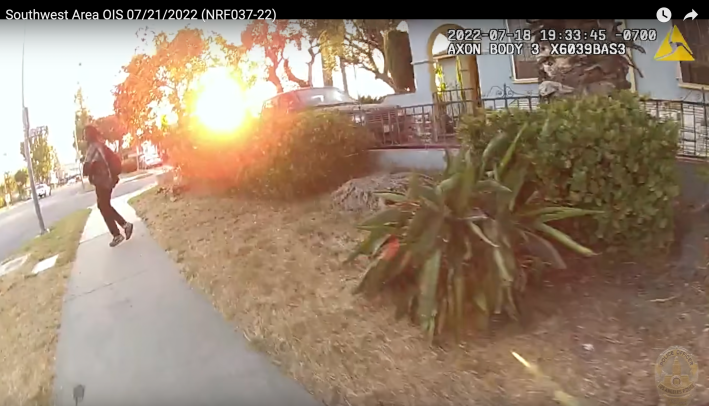
It wasn’t until nearly three seconds later – at 19:33:48-9, when Petit was facing forward and in full-on flight mode (below) – that Hayhoe fired his first shot. [CW: the shots will be heard but the image freezes before Petit is hit.]
Hayhoe told investigators he fired again because – despite absolutely all evidence to the contrary – Petit "was still facing me," he "didn't go down" after the first shot, and he "still, in my opinion, was in a position to shoot."
2. The department shows unusual deference to Hayhoe
One of the stranger things included in the Chief’s report is a reference to the testimony of a “Subject Matter Expert” from the LAPD's Training Division. The expert appears to have been enlisted by the department explicitly for the purpose of supplying a potential excuse for Hayhoe’s recklessness on his behalf. Namely, that “shooting from a moving vehicle is generally utilized during anti-ambush situations.”
The suggestion that Hayhoe - who Moore made a point of noting had worked in the Dignitary Protection Unit and thus had likely received anti-ambush training - was operating on some higher tactical plane apparently proved a bridge too far for the UOFRB. They ultimately concluded this was not an ambush scenario.
But they did largely refrain from criticizing Hayhoe’s actions outright, instead tending to frame them as reasonable, understandable, and only slightly less preferable than the choices the board felt he should have made.
The only notable exception is the critique of Hayhoe's performance as a supervisor during a critical incident - both his having inserted himself into the effort to detain Petit (instead of slowing down the approach and formulating a plan with his subordinates) and his failure to properly manage the scene after the shooting (e.g. declare himself incident commander, separate Glover out and admonish him against speaking to others about the incident, etc.).
That deference served Hayhoe well with regard to the question of drawing a weapon while operating a motor vehicle. Although the department considers drawing while driving "unsafe for both officers and the community," the board found him to be in policy, based on “the totality of the circumstances” and what appears to be a failure to question why Hayhoe didn't heed his subordinates' de-escalation.
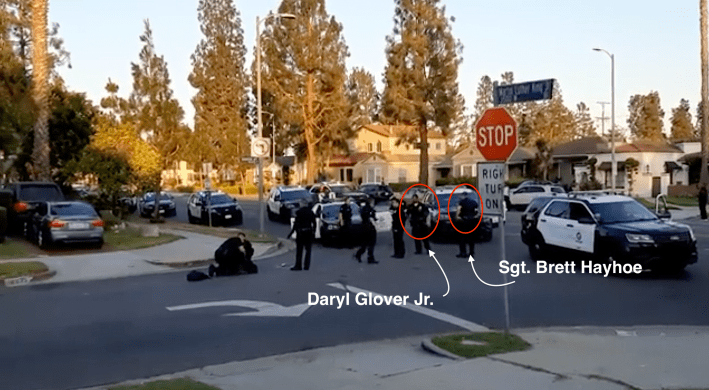
3. The bias in favor of those who open fire
Despite having been the first officer to make contact with Petit and the one to have realized the object in Petit’s hand was not a firearm, Martinez’ account of events is barely referenced throughout the 22-page report.
Its absence means there is no counterweight to the wild hyperbole spouted by Glover, the partner officer - and son of Jerretta Sandoz, the police union's Vice President - whose own breathless account also suggests an alarming lack of judgment.
Glover’s approach to Petit had been far more aggressive than Martinez’ from the outset. He had pointed his service weapon at Petit and used profanity, ordering him to “Get on the f*cking wall!” and demanding to know “What’s that in your f*cking hands?”
And even though Glover told investigators he knew the object looked “funky” before he heard Martinez say it wasn’t a gun, unlike Martinez, he didn’t pause to reassess. Instead, per his statements, he had tried to convince Martinez the object actually was a firearm. “I'm telling him, like, ‘Hey, you sure it's not a gun?’ to get his mind going like, ‘Man, maybe it is,’ you know?”

In the body cam footage, Glover sounds much more confused and appears to be preoccupied with trying to get a confirmation from Martinez about what Petit is holding. Which makes his claims about what happened next all the more surprising.
Like Hayhoe, Glover told investigators that he saw Petit stop to raise a gun at the sergeant. But Glover also claimed that when Petit was facing Hayhoe he heard two booms and concluded Petit had been the one to open fire. “At that point everything clicked. Like, OK, oh shoot, [Petit] just shot at my sergeant.”
Glover claims he subsequently opened fire “to save the life of the officer that was inside that police vehicle, to stop the actions of the suspect.”
“When I fired, the suspect was in a gunfight,” he said.
This is categorically untrue. The video shows that Glover didn't open fire until after Hayhoe had already fired two shots and Petit was almost fully prone on the ground.
In fact, none of Glover's account matches what the cameras captured.
No "booms" are heard as Petit turns to face Hayhoe. Instead, Glover and Martinez are seen raising their weapons in anticipation of Petit making a threatening move. When Petit turns away from Hayhoe and breaks into a run instead, Glover and Martinez lower their weapons and pick up their own pace in order to keep up with him.
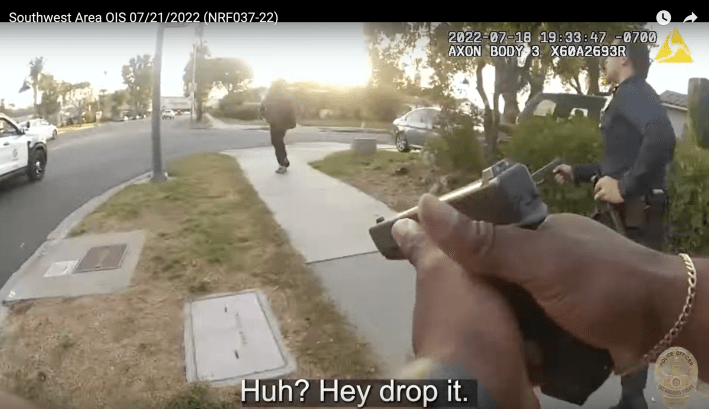
As they run - and just one second before Hayhoe first opens fire - Glover is heard saying, “Huh?” (above). He’s still trying to get an answer from Martinez about what Petit is carrying (as Martinez tells Petit to drop the object).
In other words, the more likely scenario is that Glover's attention was divided when the first shot rang out. If he was not aware Hayhoe had drawn his service weapon, he may have assumed Petit had opened fire because that was the most logical explanation for what he heard. If he did know Hayhoe's weapon was already drawn, he may have thought Hayhoe had seen some threat that Glover himself had not. Either scenario would be of great concern and confirm this was a case of contagious fire - not someone attempting to neutralize a threat that they themselves had identified.
Martinez' observations would likely offer some clarity in this regard. But they are not provided in the report. So Glover's depiction of events goes uncontested. And the UOFRB is free to conclude that another officer in the same situation would have responded as Glover did... despite Martinez having been right there and having opted not to fire.
__________
As noted earlier, the Police Commission voted in line with the Chief’s recommendations at the end of June. Their abridged findings have yet to be published. [UPDATE: 9/16/23 9:30 a.m.: The Police Commission published their findings, found here. The findings examined the body cam footage in a way that the Chief's findings did not. But, as a body, the commissioners did not challenge the inconsistencies in Hayhoe's account, even when it seemed clear they themselves had observed that Petit had been fleeing when shot (below).]
Finding Hayhoe himself "created the exigent circumstance" that led to the shooting seems to be a copspeak nod to how badly he f*cked up. But... he shot at a fleeing man while driving w/ one hand & lied about it. The @lapdcommission should be able to acknowledge his recklessness. pic.twitter.com/7hQjioiTOY
— sahra (@sahrasulaiman) September 16, 2023
In the meanwhile, it is worth noting that Officer Glover, whose mother recently took to social media to criticize the city and to tell LAPD officers leaving the job to find another agency that respects their worth (per the L.A. Times), has since been promoted to serve in the Community Safety Partnership program in the Pueblo Del Río development.
Meet Officer Glover from @lapdcsp. In just one month he put together a basketball youth team that serves youth from the Pueblo Del Río Community. The kids adore the sport, but love Ofcr Glover. @LAPDETingirides @HACLA1938 @Lakers #LA pic.twitter.com/YRdf7FSbqu
— John N (@JNegrete2014) April 8, 2023
Find me on twitter: @sahrasulaiman
For more coverage of the Petit case, see:
- LAPD Sergeant Fired at Jermaine Petit from Inside Patrol Vehicle, Sparking Contagious Fire from Officer Who Knew Petit Was Unarmed
- LAPD Describes Car Part as Resembling “Nonfunctioning Firearm” During Contentious Town Hall on Leimert Park Shooting
- A lengthy twitter thread breaking down the case in real time:





